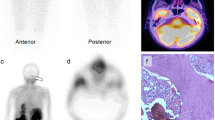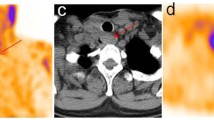Abstract
Radionuclide scanning with tumour-seeking agents such as pentavalent technetium-99m dimercaptosuccinic acid [99mTc(V)-DMSA], thallium-201 and technetium-99m sestamibi (MIBI) has been reported to be useful in the detection of medullary thyroid carcinoma (MTC). We undertook a study in 14 MTC patients to determine the comparative imaging potential of201Tl, MIBI and99mTc(V)-DMSA in the detection of recurrent or metastatic MTC. All patients underwent total thyroidectomy and had persistently elevated serum calcitonin levels after the surgery. Scintigraphic studies were carried out 20 min after the injection of 111 MBq of201Tl or 555 MBq of MIBI and 2 h following the injection of 370 MBq of99mTc(V)-DMSA. All scintigraphic findings were correlated with contemporaneous CT or MRI studies. CT, MRI and bone scans showed 42 (26 bone, 16 soft tissue) metastatic sites in 11 of the 14 patients. In the remaining three patients no lesions were detected during diagnostic evaluation.99mTc(V)-DMSA showed all of the soft tissue metastases but could not show two bone lesions. On the other hand, MIBI imaging was false-negative in 22 (52%) sites and201Tl was false-negative in 34 (80%) sites. Overall, lesion detection sensitivities for99mTc(V)-DMSA, MIBI and201Tl were 95%, 47% and 19% respectively. We conclude that99mTc(V)-DMSA is clearly superior to MIBI and201Tl in the follow-up of MTC patients.
Similar content being viewed by others
References
Brunt LM, Wells SA. Advances in the diagnosis and treatment of medullary thyroid carcinoma.Surg Clin North Am 1987; 67: 263–279.
Sisson JC, Ackermann R, Meyer MA, Wahl RL. Uptake of FDG by thyroid cancer: implications for diagnosis and therapy.J Clin Endocrinol Metab 1993; 77: 1090–1094.
Ohta H, Yamamato K, Endo K, Mori T, Hamanaka D, Shimazu A, Ikekubo K, Makimoto K, Lida Y, Konishi J, Morita R, Hata N, Horiuchi K, Yokoyama A, Torizuka K, Kuma K. A new imaging agent for medullary carcinoma of the thyroid.J Nucl Med 1984; 25: 323–325.
Clarke SEM, Lazarus CR, Wraight P, Sampson C, Maisey MN. Pentavalent [99mTc] DMSA, [131I]MIBG, and [99mTc] MDP — an evaluation of three imaging techniques in patients with medullary carcinoma of the thyroid.J Nucl Med 1988; 29: 33–38.
Clarke SEM. Medullary thyroid cancer. In: Murray IPC, Ell PC, Strauss HW, eds.Nuclear medicine in clinical diagnosis and treatment. New York: Churchill Livingstone; 1994; 677–685.
Arnstein NB, Juni JE, Sisson JC, Lloyd RV, Thompson NW. Recurrent medullary thyroid carcinoma of the thyroid demonstrated by thallium-201 scintigraphy.J Nucl Med 1986; 27: 1564–1568.
O'Driscoll CM, Baker F, Casey MJ, Duffy GJ. Localization of recurrent medullary thyroid carcinoma with technetium-99m-methoxyisobutylnitrile scintigraphy: a case report.J Nucl Med 1991; 32: 2281–2283.
Lebouthillier G, Morais J, Picard M, Picard D, Chartrand R, D'amour P. Tc-99m-sestamibi and other agents in the detection of metastatic medullary carcinoma of the thyroid. Clin Nucl Med 1993; 18: 657–661.
Frohman LA. Endocrine manifestations of neoplasia. In: Braunwald E, Isselbacher KJ, Petersdorf RG, Wilson JD, Martin JB, Fauci AS, eds.Harrison's principles of internal medicine, 11th edn. New York: McGraw-Hill; 1987: 1597–1600.
Wahl RL. Positron emission tomography: applications in oncology. In: Murray IPC, Ell PJ, Strauss HW eds.Nuclear medicine in clinical diagnosis and treatment. New York: Churchill Livingstone; 1994: 801–820.
Fulham MJ. PET with [18F] fluorodeoxyglucose (PET-FDG): an indispensable tool in proper management of brain tumors. In: Hubner KF, Collmann J, Buonocore E, Kabalka GW, eds.Clinical positron emission tomography. St. Louis: Mosby-Year Book; 1992: 50–60.
Waxman AD. Thallium-201 in nuclear oncology. In: Freeman LM, ed.Nuclear medicine annual. New York: Raven Press; 1991: 193–209.
Abdel-Dayem HM, Scott AM, Macapinlac HA, El-Gazzar AH, Larson SM. Role of201Tl chloride and99mTc sestamibi in tumor imaging. In: Freeman LM, ed.Nuclear medicine annual. New York: Raven Press; 1994: 181–234.
Uğur Ö, Kostakoğlu L, Caner B, Güler N, Gülaldi NCM, Özmen M, Uysal U, Elahi N, Erbengi G, Bekdik C. Comparison of T1-201, Tc-99m-MIBI and I-131 imaging in the followup of patients with well differentiated thyroid carcinoma.Nucl Med Commun 1996; 17: 373–377.
Author information
Authors and Affiliations
Rights and permissions
About this article
Cite this article
Uğur, Ö., Kostakoğlu, L., Güler, N. et al. Comparison of99mTc(V)-DMSA,201Tl and99mTc-MIBI imaging in the follow-up of patients with medullary carcinoma of the thyroid. Eur J Nucl Med 23, 1367–1371 (1996). https://doi.org/10.1007/BF01367593
Received:
Revised:
Issue Date:
DOI: https://doi.org/10.1007/BF01367593




